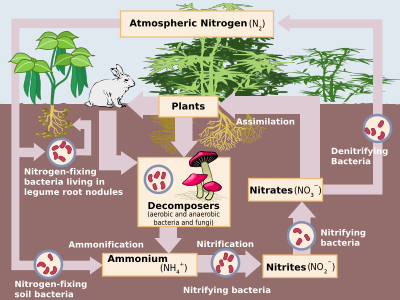Here are the nitrogen-fixing nodules on the roots of our young saplings. These rhizobia nodules develop on young lucerne trees’ roots once they are potted into the soil or planted in your lands.

“Rhizobia is the group of soil bacteria found in the soil that infect the roots of legumes to form root nodules where they fix nitrogen gas (N2) from the atmosphere turning it into a more readily useful form of nitrogen. Rhizobia live in a symbiotic relationship with legumes. From here, the nitrogen is exported from the nodules and used for growth in the legume.” Wikipedia
This glorious tree, as well as all other legumes such as clover, alfalfa, beans, peas, and soybeans, develop rhizobia nodules on their roots which feed themselves, your soils and their neighboring plants with nitrogen! This means that your lucerne tree provides its own fertilizer and shares this with nearby plants, making it an incredible, full-time, fertilizer-producing companion plant to your fruit trees and vegetable gardens – a permaculture wonder plant!
Many poor farmers do not have access to fertilizers, so the sustainability of rhizobial inoculum is an important aspect in saving money. Other crops planted after a legume are healthier and higher yielding, so planting food forests, vegetables and fruits near or under lucerne trees will automatically receive this wonderful “free” fertilizer.

Because our seeds and saplings come from soils that already have this bacteria, our trees do not require an inoculant. However, if you prefer to inoculate your seeds we recommend the Groundnut & Cowpea Group Inoculant which contains Bradyrhyzobium sp. (Vigna) bacteria, a bacterial legume inoculant. We do not supply inoculant, but you can order a packet from your local agricultural supplier. Once your trees establish rhizobia, they will automatically ‘infect’ your soils with this bacteria and your trees and their seeds will not require any additional inoculant.
Do NOT add any nitrogen-rich fertilizer or manure when you plant out your young trees. This added nitrogen will prevent your saplings’ roots from developing and forming their rhizobia nodules and nitrogen can actually burn their sensitive feeder roots at this stage.
We do add about 50g of rock phosphorous in each hole when we plant out our young trees. Phosphorus is an essential nutrient for plants in the nitrogen cycle. Higher nitrogen levels will help to make more phosphorus (and other minerals) available for the plants, but by making sure there is available phosphorus at the beginning it will speed up the whole process. With time and larger sized plants, and with mycorrhiza fungi inoculation and efficient nitrogen fixation, your lucerne trees will be able to make phosphorus that’s already in the soil available. You can read more here – permaculturenews.org. We always add a generous amount of compost into our holes when we plant out our trees.
Happy farming!
Hi Can you give me instructions on the most proven way of starting a plant from seed. I am nor plant savy so I really need a planting seed guide for dummys🤣. We have a serious kangaroo issue so I will need to protect the plant from them. I want to know when to plant my seed, what month is best I am in Australia in Victoria. What should I start the seed in. How long before it shows a seedling. What sort of watering should I do. I am sure your busy and u understand if you can’t answer my book of questions
On Wed, 27 Mar. 2019, 9:14 pm Lucerne Tree Farm, wrote:
> Nadene posted: “Here are the nitrogen-fixing nodules on the roots of our > young saplings. These rhizobia nodules develop on young lucerne trees’ > roots once they are potted into the soil or planted in your lands. > “Rhizobia is the group of soil bacteria found in the soil” >
LikeLike
@kate mitchell Our blog is pretty much the most comprehensive “dummies” guide to farming with Lucerne trees. Please simply work through the Seeds page (https://lucernetreefarm.wordpress.com/seeds/) to see all our detailed step-by-step instructions and photos. To answer your other questions —
* Keep the kangaroos out! Fence in your entire field where you have planted your young trees or place wire mesh cages around each tree.
* Spring time is the best time to plant trees. We also plant our trees in our South African winters as we fall in a winter rainfall region.
* Seeds take between 15 days to 40 days to emerge and form their first true leaves.
* Do NOT overwater!!!! Water lightly but regularly. It is best to feel the soil to assess if it is dry before watering.
LikeLike
[…] https://lucernetreefarm.wordpress.com/2019/03/27/lucerne-trees-nitrogen-fixing-nodules/ — Read on lucernetreefarm.wordpress.com/2019/03/27/lucerne-trees-nitrogen-fixing-nodules/ […]
LikeLike
[…] Fix nitrogen and are the “givers” feeding other plants, shrubs and trees. […]
LikeLike
[…] tree seeds. The lucerne tree is a part of the legume family, similar to peas and beans, and can fix nitrogen in the soil through special rhizobia nodules that form on their roots. These nodules can take nitrogen from the […]
LikeLike
[…] Inoculant is added to ensure that legumes’ (nitrogen-fixing plants) roots will have the necessary bacteria present to help develop nitrogen-fixing nodules on their roots. And because most healthy soils contain natural rhizobia, it is NOT necessary to add inoculant to your seed germination process as the plant and bacteria naturally occuring in the soil will do their magic and form the symbiotic relationship that will cause the roots to form nitrogen-fixing nodules. I wrote about this process here –Lucerne trees’ nitrogen-fixing nodules. […]
LikeLike